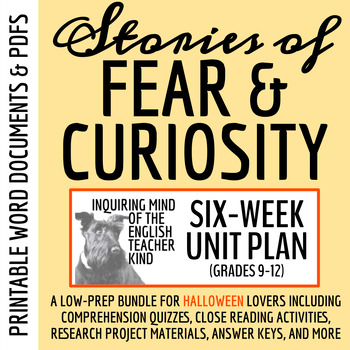Thematic Short Story Unit Plan on Fear and Curiosity for High School (Printable)
- Zip
- Easel Assessment
Products in this Bundle (17)
showing 1-5 of 17 products
Bonus
Description
Embrace the Halloween spirit and help high school students interpret and analyze short stories of increasing rigor with this low-prep, six-week thematic unit plan on the power of fear and curiosity. Supporting materials such as comprehension quizzes, close reading analysis worksheets, public domain narratives, research project materials, a summative assessment, a test prep study guide, and answer keys are provided. Materials are delivered in Word Document and PDF formats. (Alternatively, a Google Drive option is available.)
The following narratives are featured:
- "Graves and Goblins" by Nathaniel Hawthorne
- "Hansel and Gretel" by the Brothers Grimm
- "The Emissary" by Ray Bradbury
- "The Lurking Fear" by H.P. Lovecraft
- "The Mortal Immortal" by Mary Shelley
- "The Wife's Story" by Ursula K. Le Guin
- "The Woman's Ghost Story" by Algernon Blackwood
Using these texts, students will consider answers to these essential questions:
- What is fear? How can it affect an individual physically, emotionally, and psychologically?
- What is curiosity? How does it affect an individual’s behavior?
- How does experiencing fear and curiosity compromise one’s judgment?
- How do one’s experiences with fear and curiosity affect others?
- How does setting influence decision-making for characters who experience fear and curiosity?
- What aspects of an author’s works evoke characteristics of Halloween?
By the end of the unit, students will have opportunities to learn the following:
- The conventions of Gothic fiction, also known as Dark Romanticism
- How authors use a variety of narrative techniques to develop compelling narratives with complex characters and vivid settings
- How to analyze character development and connect plot details to larger themes
- Details associated with the history of Halloween
- How to gather, organize, synthesize, and articulate information obtained through a structured research process
By the end of the unit, students will have opportunities to demonstrate the following skills:
- Identifying what works of fiction and nonfiction state explicitly and implicitly
- Articulating facts, claims, and inferences with clarity, accuracy, and precision, citing relevant evidence to support and strengthen ideas
- Applying knowledge of literary devices such as metaphor, simile, hyperbole, foreshadowing, personification, and more
- Discussing literature in meaningful ways and in various contexts
- Exploring shared themes among several texts
Other important features of the unit plan include the following:
- A list of the relevant Common Core Standards attached to the unit
- An alphabetized list of essential vocabulary terms
- A week-by-week breakdown of assigned texts and general tasks
- A suggested list of bell ringer writing prompts, one for each text
- Ideas for differentiating instruction and assessment
Additional unit plans are available:
- Writing Adventure Fiction - Google and printable
- Writing Dinosaur Tales - Google and printable
- Writing Fairy Tales - Google and printable
- Writing Fantasy Fiction - Google and printable
- Writing Gothic Fiction - Google and printable
- Writing Realistic Fiction - Google and printable
- Writing Science Fiction - Google and printable





